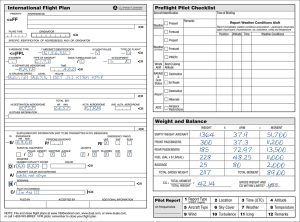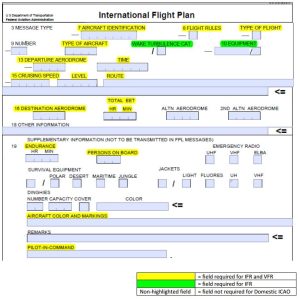The FAA proposal to implement a standardized flight plan filling using the International ICAO flight plan form will soon take effect. As I mentioned last week, the FAA has removed all U.S. format flight plan questions from the knowledge exams. New updated question relating to the ICAO form will eventually replace those questions that have been removed. Before this takes place, just take some time to become acquainted with this the ICAO form.
FAA Form 7233-4 (International Flight Plan) is shown in the figure above. The filer is normally responsible for providing the information required in Items 3 through 19. The information below is intended to be a brief guideline in filling out the flight plan form; additional information can be found in the Aeronautical Information Manual (AIM) Section 1, ¶5-1-9 and at www.1800wxbrief.com
Item 3
MESSAGE TYPE: FPL
Item 7
AIRCRAFT IDENTIFICATION: Insert the full registration number of the aircraft (“N” number).
Item 8
FLIGHT RULES: Enter one of the following letters to denote the category of flight rules with which the pilot intends to comply: V (VFR), I (IFR), Y (IFR to VFR), Z (VFR to IFR).
TYPE OF FLIGHT: Enter one of the following to denote the type of flight: G (General Aviation).
Item 9
NUMBER: Enter the number of aircraft if more than one.
TYPE OF AIRCRAFT: Enter the aircraft type designator (i.e. C172, for a Cessna 172).
Note: You can search for your aircraft ICAO designator here http://www.icao.int/publications/doc8643/pages/search.aspx
WAKE TURBULENCE CATEGORY: L (Light)
Item 10
EQUIPMENT: Enter radio communication, navigation and approach aid equipment and capabilities. After / enter surveillance equipment and capabilities.
Note: A complete listing of Aircraft COM, NAV, and Approach Equipment Qualifiers can be found in the AIM table 5-1-4. Aircraft Surveillance Equipment, Including Designators for Transponder, ADS-B, ADS-C, and Capabilities are listed in table 5-1-5 of the AIM.
Item 13
DEPARTURE AERODROME: Insert the ICAO identifier of your departure airport.
TIME: Enter the estimated departure time.
Item 15
CRUISE SPEED: Insert the true airspeed for the first or the whole cruising portion of the flight, in terms of knots, expressed as N followed by 4 digits (e.g. N0125 for 125 knots).
LEVEL: Insert the planned cruising altitude in hundreds of feet for the first or the whole portion of the route to be flown expressed as A followed by 3 figures (e.g. A075 for 7,500 feet MSL).
ROUTE: Insert your intended route of flight.
Item 16
DESTINATION AERODROME: Insert the ICAO identifier of your destination airport.
TOTAL EET: Insert your total estimated elapsed time (your time en route).
ALTERNATE AERODROME: Insert the ICAO identifier of any alternate airports (optional).
Item 18
OTHER INFORMATION: Insert 0 (zero) if no other information. If other information needs to be entered use the appropriate indicators when available (e.g. SAR for a flight engaged in search and rescue).
Item 19
SUPPLEMENTARY INFORMATION: Item 19 data must be included when completing Flight Plan form. This information will be retained by the facility/organization that transmits the flight plan to Air Traffic Control (ATC), for Search and Rescue purposes, but it will not be transmitted to ATC as part of the FPL.
E/ (ENDURANCE): Insert 4-digits group giving the fuel endurance in hours and minutes.
P/ (PERSONS ON BOARD): Insert the total number of persons (passengers and crew) on board.
R/ (RADIO):
Cross out “UHF” if frequency 243.0 MHz is not available.
Cross out “VHF” if frequency 121.5 MHz is not available.
Cross out “ELBA” if emergency locator transmitter (ELT) is not available.
S/ (SURVIVAL EQUIPMENT):
Cross out “POLAR” if polar survival equipment is not carried.
Cross out “DESERT” if desert survival equipment is not carried.
Cross out “MARITIME” if maritime survival equipment is not carried.
Cross out “JUNGLE” if jungle survival equipment is not carried.
J/ (JACKETS):
Cross out “LIGHT” if life jackets are not equipped with lights.
Cross out “FLUORES” if life jackets are not equipped with fluorescein.
Cross out “UHF” or “VHF” or both as in R/ above to indicate radio capability of jackets, if any.
D/ (DINGHIES):
NUMBER: Cross out indicators “NUMBER” and “CAPACITY” if no dinghies are carried, or insert number of dinghies carried; and
CAPACITY: Insert total capacity, in persons, of all dinghies carried; and
COVER: Cross out indicator “COVER” if dinghies are not covered; and
COLOR: Insert color of dinghies if carried.
A/ (AIRCRAFT COLOR AND MARKINGS): Insert color of aircraft and significant markings.
N/ (REMARKS): Cross out indicator N if no remarks, or indicate any other survival equipment carried and any other remarks regarding survival equipment.
C/ (PILOT-IN-COMMAND): Insert name of pilot-in-command.

For additional information click here. We include the ICAO flight plan form as part of our flight planner pad (ASA-FP-3), ideal for both domestic and international preflight planning and in-flight progress tracking.





